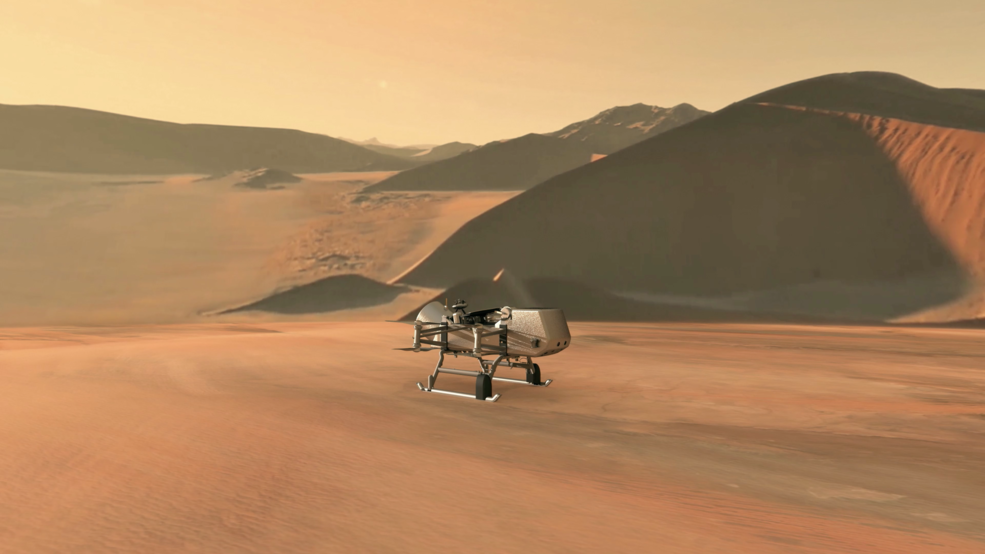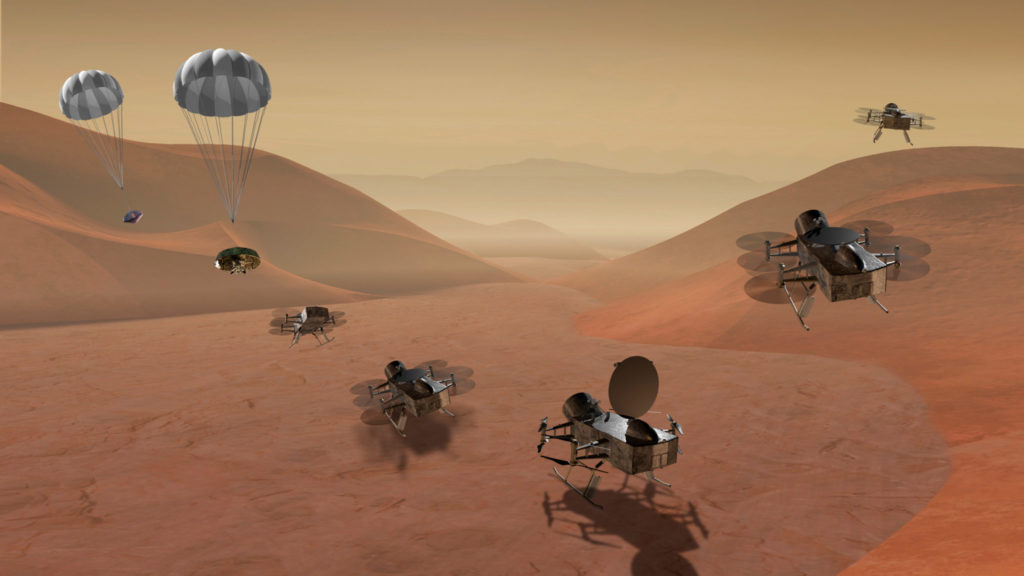NASA is sending a billion-dollar quadcopter on a mission to search for signs of life on Saturn’s largest moon.
The Dragonfly mission will send the car-sized drone soaring over the alien dune fields and impact craters of the “unique, richly organic” world Titan.
The craft will fly to dozens of promising locations in a search for the chemical process and conditions that could foster life.
The quadcopter has eight rotors and flies like a large drone.
 This illustration shows NASA’s Dragonfly rotorcraft-lander approaching a site on Saturn’s exotic moon, Titan. Image: NASA/JHU-APLn
This illustration shows NASA’s Dragonfly rotorcraft-lander approaching a site on Saturn’s exotic moon, Titan. Image: NASA/JHU-APLnNASA said it will begin its mission by taking short-hop flights before building up to a series of longer 8km “leapfrog” flights.
It is designed to travel a total of 175km across Titan’s surface – nearly double the distance travelled by all the Mars Rovers combined.
“With the Dragonfly mission, NASA will once again do what no one else can do,” said NASA Administrator Jim Bridenstine.
“Visiting this mysterious ocean world could revolutionize what we know about life in the universe.
“This cutting-edge mission would have been unthinkable even just a few years ago, but we’re now ready for Dragonfly’s amazing flight.”
 Titan and Saturn have very few things in common, but a hazy appearance is one feature they share. Image: NASA/JPL-Caltech/Space Science Institute
Titan and Saturn have very few things in common, but a hazy appearance is one feature they share. Image: NASA/JPL-Caltech/Space Science InstituteTitan boasts the only known surface seas in the solar system outside Earth, as well as clouds and rain – all of which are composed of liquid methane.
Other organics are formed in the moon’s atmosphere and fall like snow.
At a distance of 1.4 billion km from the sun, the moon’s surface temperature of -179C is far too cold for liquid water to exist; however, scientists suspect there may be a salty ocean beneath its icy crust.
The moon is larger than the planet mercury and as geographically diverse as Earth with impact craters, lakes, rivers and dunes to explore.
 This illustration shows NASA’s Dragonfly rotorcraft-lander approaching a site on Saturn’s exotic moon, Titan. Image: NASA/JHU-APL
This illustration shows NASA’s Dragonfly rotorcraft-lander approaching a site on Saturn’s exotic moon, Titan. Image: NASA/JHU-APL“Titan is unlike any other place in the solar system, and Dragonfly is like no other mission,” said Thomas Zurbuchen, NASA’s associate administrator for Science.
“It’s remarkable to think of this rotorcraft flying miles and miles across the organic sand dunes of Saturn’s largest moon, exploring the processes that shape this extraordinary environment.
“Dragonfly will visit a world filled with a wide variety of organic compounds, which are the building blocks of life and could teach us about the origin of life itself.”
 This picture of the surface of titan was taken by the Huygens lander as part of the Cassini mission
This picture of the surface of titan was taken by the Huygens lander as part of the Cassini missionTitan has a nitrogen-based atmosphere like Earth and NASA said it has all of the ingredients, weather and surface processes necessary to help life form.
NASA said Dragonfly will explore “diverse environments from organic dunes to the floor of an impact crater where liquid water and complex organic materials key to life once existed together for possibly tens of thousands of years.”
Its instruments will study how far prebiotic chemistry may have progressed on the moon, while also investigation its surface, its atmosphere and its subsurface ocean.
It will also search for chemical evidence of past or extant life.
Dragonfly is due to launch in 2026 and arrive in 2034. It will spend at least two years and eight months exploring Titan.








